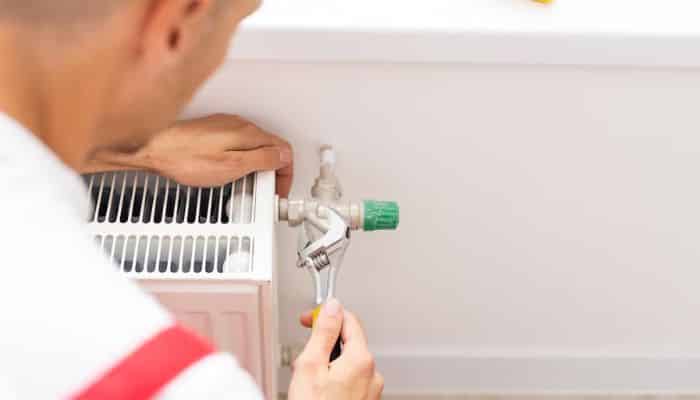To bleed a radiator, turn off your heating, use a radiator key to open the bleed valve slightly, let trapped air escape until water flows, then close the valve and check your boiler pressure. This quick DIY fix restores heat and improves efficiency. If your radiators have cold spots, make gurgling noises, or heat unevenly, bleeding them can often solve the problem without needing professional heating services. This guide will help you handle one of the most common heating problems quickly and safely.
What Does It Mean to Bleed a Radiator?
Bleeding a radiator means releasing trapped air from the system. Over time, air can enter your central heating system and get stuck in radiators. When this happens, the top part of the radiator may feel cold while the bottom is hot, signaling that it’s not heating up evenly or efficiently.
By removing the trapped air, you allow hot water to circulate freely, restoring full heating power and improving energy efficiency. This process is known as the radiator bleeding procedure, and it’s something you can usually do yourself without calling a professional.
Signs Your Radiator Needs Bleeding
Before diving into the how-to, let’s look at common signs that indicate your radiator may need bleeding:
-
The radiator is cold at the top but warm at the bottom
-
You hear gurgling or clanking noises when the heating is on
-
The heating system takes longer to warm up
-
Uneven heating in different rooms
These signs typically mean there’s air trapped inside the radiator that needs to be released.
Tools You’ll Need to Bleed Your Radiator
You don’t need much to bleed a radiator, but having the following items ready will make the job easier:
-
Radiator key (or a flathead screwdriver, depending on your radiator)
-
A cloth or towel
-
A bowl or small container (to catch drips)
-
Gloves (optional, for cleanliness and safety)
Step-by-Step Radiator Bleeding Procedure
Step 1: Turn Off the Heating
Make sure your central heating system is turned off and allow the radiators to cool down completely. Bleeding a hot radiator can be dangerous, as hot water and steam may escape.
Step 2: Locate the Bleed Valve
The bleed valve is usually located at the top corner of the radiator. It’s a small, square-shaped hole that you’ll open with a radiator key.
Step 3: Place a Towel and Bowl Under the Valve
Put an old towel or cloth under the valve and place a bowl beneath it to catch any water that might come out. Some water is likely to escape along with the air.
Step 4: Insert the Radiator Key
Insert the radiator key into the bleed valve and turn it slowly counterclockwise—just a quarter to a half turn is enough. You’ll hear a hissing sound as the trapped air begins to escape.
Step 5: Wait for the Water
Keep the valve open until the hissing stops and a steady stream of water starts to come out. This means all the air has been released. At this point, close the valve by turning the key clockwise.
Step 6: Check the Boiler Pressure
After bleeding your radiators, it’s essential to check the boiler pressure after bleeding. Bleeding releases not only air but a small amount of water, which can lower the pressure in your boiler.
Check your boiler’s pressure gauge—it should typically read between 1 and 2 bars when the system is cold. If it’s too low, you’ll need to top up the pressure using the boiler’s filling loop. Consult your boiler’s manual if you’re unsure how to do this.
Step 7: Turn the Heating Back On
Now that the radiator is bled and your boiler pressure is in the right range, turn your heating system back on. Check to see if the radiator heats up evenly. If it does, you’ve done the job correctly.
Safety Tips and Common Mistakes While Bleeding a Radiator
While bleeding a radiator is generally safe and straightforward, here are a few tips to help you avoid common pitfalls:
-
Never open the bleed valve fully — just a small turn is enough.
-
Always start with the radiator farthest from the boiler — this can help move air through the system more efficiently.
-
Keep an eye on boiler pressure — bleeding radiators reduces pressure slightly.
-
Don’t ignore persistent issues — if radiators remain cold after bleeding, there may be a larger issue with your central heating system.
What to Do After Bleeding Radiators?
After you’ve bled your radiators, turn the heating back on and check them again. Make sure they are heating evenly from top to bottom. Listen for any unusual noises and monitor how quickly the rooms heat up.
Check your boiler pressure one more time after the system has run for a bit. If everything looks good, congratulations! You’ve successfully completed the radiator bleeding procedure.
Final Thoughts
Bleeding your radiators is one of the simplest DIY tasks you can perform to maintain a healthy and efficient central heating system. It requires minimal tools, takes only a few minutes, and can significantly improve your home’s comfort and reduce energy costs.
By following this step-by-step guide, you’ll be better equipped to manage your heating system and spot early signs of trouble. Whether it’s before the winter season or during routine maintenance, knowing how to bleed a radiator properly ensures your home stays warm and cozy year-round.


 855-410-TECH(8324)
855-410-TECH(8324) APPLY FOR FINANCING
APPLY FOR FINANCING